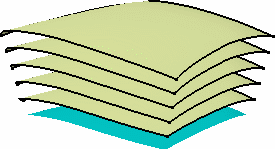It can be any type of surface, including multi-patch surfaces resulting from fill or any other operation.
-
Click Offset
 .
.The Offset Surface Definition dialog box appears. 
-
Select the Surface to be offset.
An arrow indicates the proposed direction for the offset. -
Specify 200mm as the Offset value.

-
Click Preview to preview the offset surface.
The offset surface is displayed normal to the reference surface. 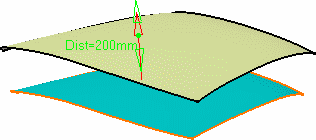
-
Click OK to create the surface.
The surface (identified as Offset.xxx) is added to the specification tree. 
- Depending on the geometry configuration and the offset value, an offset may not be allowed as it would result in a debased geometry. In this case, you need to decrease the offset value or modify the initial geometry.
- When you modify an input value through the dialog box, such as the offset value or the direction, the result is computed only when you click Preview or OK.
- Parameters can be edited in the 3D geometry. To have further information, refer to the Editing Parameters chapter.
Setting Optional Parameters
![]()
- You can display the offset surface on the other side of the reference
surface by clicking either the arrow or the Reverse Direction
button.
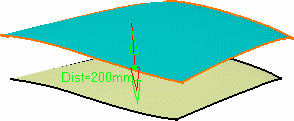
- You can define a smoothing type on the offset surface:

- None: the smoothing is constant. This is the default type.
- Automatic (you can use the
Offset3.CATPart document):
a local smoothing is applied only if the constant offset cannot be
performed. It cleans the geometry of the surface and enables the
offset.
A warning panel is launched and the modified surface is shown in the 3D geometry. If a surface still cannot be offset, no smoothing is performed and a warning message is issued (as in the constant offset mode). If you click Yes, erroneous sub-elements are removed and the offset operation goes on. - Manual: a local smoothing is
applied as in the Automatic type. You need to define a Maximum
Deviation below which the elements are to be offset. If the
resulting deviation is greater than the defined deviation, no smoothing
is performed and a warning message is issued (as in the constant offset
mode). If you click Yes, erroneous sub-elements are
removed and the offset operation goes on.

- The deviation should be comprised between 0.001mm and the Offset value (-0.1mm). For instance, if the Offset value is 20mm, the maximum deviation is 19.9mm.
- The Maximum Deviation field is only available with the Manual smoothing type.
- generate two offset surfaces, one on each side of the reference
surface, by checking the Both sides option.
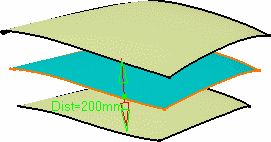
- create several offset surfaces, each separated from the initial surface by a multiple of the offset value, by checking the Repeat object after OK option.
- Would the value be inconsistent with the selected geometry, a warning
message is displayed, along with a warning sign onto the geometry.
If you move the pointer over this sign, a longer message is displayed to help you continue with the operation. Furthermore, the manipulator is locked, and you need to modify the value within the dialog box and click Preview. 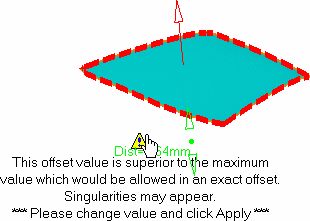
Removing Sub-Elements
The Sub-Elements to remove tab helps you for the analysis in case the offset encounters a problem.
Open the Offset2.CATPart document.
-
Perform steps 1 to 3.
-
Click Preview.
The Warning dialog box appears, the geometry shows the erroneous sub-elements, and flag notes display sub-elements to remove. 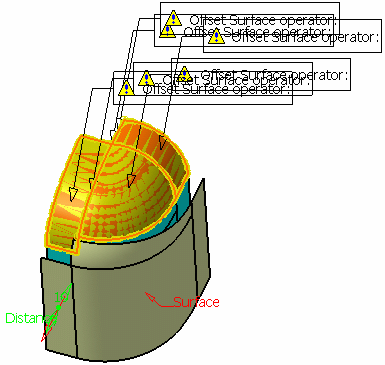
-
Click Yes to accept the offset.
-
Click Preview.
The offset surface is displayed normal to the reference surface. -
Click OK to create the surfaces.
The surfaces (identified as Offset.xxx) are added to the specification tree. 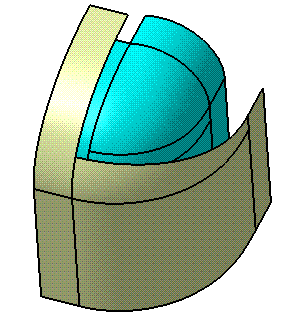
Performing a Temporary Analysis
-
Perform steps 1 to 3 (set 20mm as the Offset value).
-
Click Preview.
The Temporary Analysis icon is available from the Tools toolbar. -
Click Temporary Analysis mode
 .
. -
Select the analysis to be performed in the Analysis toolbar by clicking either Connect checker
 or Curve connect checker
or Curve connect checker
 .
. -
Click OK in the Connect checker or Curve connect checker dialog box.

You must activate the temporary analysis mode before running any analysis. Otherwise, a persistent analysis will be performed.
The Temporary Analysis node is displayed in the specification tree and the associated analysis (here Curve Connection Analysis.1) appears below.

- The analysis is not persistent. Thus when you click OK in the Offset Definition dialog box to create the curve, the Temporary Analysis node disappears from the specification tree.
- An option is available from Tools -> Options to let you automatically set the analysis as temporary. Refer to the Customizing section.
![]()
